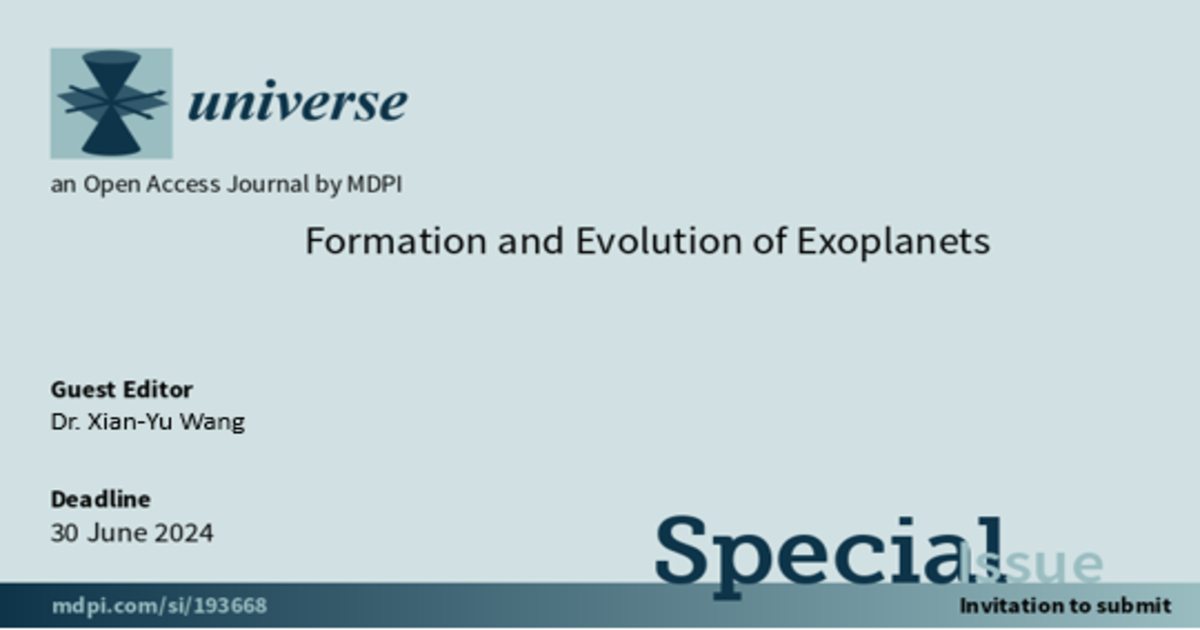Formation and Evolution of Exoplanets
A special issue of Universe (ISSN 2218-1997). This special issue belongs to the section "Planetary Sciences".
Deadline for manuscript submissions: 30 June 2024 | Viewed by 1012

Special Issue Editor
Special Issue Information
Dear Colleagues,
Over the past two decades, advancements in astronomical instrumentation have led to the discovery of more than 5,500 extrasolar planets, or exoplanets. The diverse architectures of these exoplanetary systems have challenged conventional theories of planetary system formation and evolution, which were initially inspired by our observations of the Solar System. The discovery of hot Jupiters, Jupiter-sized planets with a typical three-day orbital period, was particularly astonishing, and the processes behind their formation and migration to their current positions remain an enigma. Similarly, the absence of Super-Earth planets in our Solar System, which are the most common type in our galaxy and usually about twice the size of Earth with up to ten times its mass, is still an unresolved mystery. Furthermore, the dynamical history of planets with extremely short or long orbits is still not fully understood. Ultimately, determining how to place our Solar System in the context of all planetary systems remains a crucial question.
Drawing on an extensive array of observational data from both ground-based and space-based instruments and projects, coupled with significant theoretical efforts, we are making strides in addressing intricate challenges in exoplanet research. The ongoing pursuit of a unified theory for the formation and evolution of exoplanets, still in progress, promises not only to enhance our understanding of planetary dynamics and orbits but also to potentially transform our concepts of habitability, life's existence, and environmental diversity in uncharted planetary systems.
This Special Issue aims to collect contributions on topics related to the formation and evolution of exoplanets, including observational evidence from photometric, spectroscopic, and astrometric follow-ups, dynamical simulations, theoretical explanations, and more. Additionally, we also welcome papers on instruments, methods, and techniques designed to solve related problems. This issue seeks to capture the latest advancements and perspectives in the formation and evolution of exoplanets, further enriching our comprehension of these distant worlds and their intricate natures.
Dr. Xian-Yu Wang
Guest Editor
Manuscript Submission Information
Manuscripts should be submitted online at www.mdpi.com by registering and logging in to this website. Once you are registered, click here to go to the submission form. Manuscripts can be submitted until the deadline. All submissions that pass pre-check are peer-reviewed. Accepted papers will be published continuously in the journal (as soon as accepted) and will be listed together on the special issue website. Research articles, review articles as well as short communications are invited. For planned papers, a title and short abstract (about 100 words) can be sent to the Editorial Office for announcement on this website.
Submitted manuscripts should not have been published previously, nor be under consideration for publication elsewhere (except conference proceedings papers). All manuscripts are thoroughly refereed through a single-blind peer-review process. A guide for authors and other relevant information for submission of manuscripts is available on the Instructions for Authors page. Universe is an international peer-reviewed open access monthly journal published by MDPI.
Please visit the Instructions for Authors page before submitting a manuscript. Submitted papers should be well formatted and use good English. Authors may use MDPI's English editing service prior to publication or during author revisions.
Keywords
- exoplanets
- planetary system formation and evolution
- planetary architectures
- planetary dynamics
- observational astronomy
- astrophysical methods and techniques





